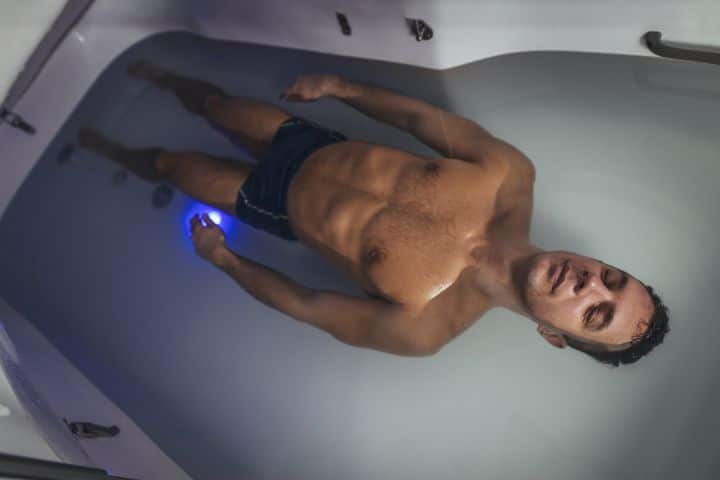You may have heard a lot about trying out a sensory deprivation tank, and how it’s incredibly beneficial for your well-being. If you haven’t tried one before, though, you might have questions about exactly what a sensory deprivation tank is and how it will help you.
Here’s what you need to know about sensory deprivation tanks, and how they can benefit your overall health.
Contents
What, Exactly, Is a Sensory Deprivation Tank?
These tanks have a few different names they could be listed under, but the most common are isolation tanks or floatation therapy tanks. In short, it is a dark, soundproof tank that is filled with a foot (or less) of salt water.
These tanks are used for restricted environmental stimulation therapy. The first tank was designed in 1954, and it was initially used for studying consciousness when cutting off all outside stimuli. However it wasn’t under the 1970s that the tanks were used commercially and the health benefits of float tanks started to be known.
Today, though, it’s very easy to find a sensory deprivation tank in almost all cities. There are many float centers and spas offering float therapy.
These tanks have been known to provide health benefits for better sleep, muscle relaxation, and decreasing anxiety and stress. Floatation therapy can also help relieve those who are living with chronic pain.
How Does a Sensory Deprivation Tank Work?
The tank itself may look different from place to place, depending on where you go for the therapy but they all work in the same way. The tank itself is designed to be soundproof and dark so that any outside stimuli can be removed from your experience.
The tank will have about a foot of water in it, just enough that you can stay afloat. The water in the tank is saturated in Epsom salt (or magnesium sulfate), and that provides the buoyancy needed to keep you completely afloat during your session.
When you start the session, you will enter the tank completely naked (usually – if you feel more comfortable wearing a bathing suit, chat with the facility and see if they are ok with it). The tank will usually have some music playing at the beginning to get you into a state of relaxation, but it most likely won’t be playing for the remainder of the session.
The tank will not have any light or sound in it, and floating in the water even relieves the pressure of gravity on your body so you will experience almost complete weightlessness. This experience sets you up for your brain to enter a state of very deep relaxation.
You may also like Best Heating Pads for Sciatica
Will You Hallucinate While Inside the Tank?
Some people who have used sensory deprivation tanks repot that they experienced hallucinations while inside the tank, while others did not have this same experience.
This has been studied for a number of years, and those studies have found that the tank does put a user into a state of very deep relaxation. This state, for some people, does produce hallucinations or a psychosis-like state – but they are only temporary.
You may or may not have this same experience – it’s an individual thing that no one can predict, really. The point of the sensory deprivation tank is to reduce all of the outside noise and stimuli so that you can completely relax – and that includes your brain, which is why some people experience these hallucinations.
How Does a Sensory Deprivation Tank Benefit You?
As already mentioned, the experience and benefits of the sensory deprivation tanks are not the same across the board for everyone. It has been shown that these tanks do benefit almost everyone who uses them, but the way those benefits show could be different.
Concentration and Focus
There have been multiple studies on this, and the answer varies by person. Although, the outcome may be different by person, the general consensus is that the sensory deprivation tanks can help with your concentration and focus in all areas of your life.
Creativity
Similar to concentration and focus, this could depend on the person using the sensory deprivation tank to begin with. Overall, though, if your job requires you to be creative these tanks can really help increase your creativity. Spending time relaxing your brain and letting go of trying to be creative has been shown to help bring those ideas to you after you get out of the tank.
You may also like Best Vibration Plate Machine for Home Use
Athletic Performance
The effects of sensory deprivation tanks on athletic performance have been well documented over the years. It has been found to help with recovery time by decreasing blood lactate. Additionally, it can been found to help with psychological recovery after very intense training, or to help athletes focus on a big event they have coming up.
Anxiety
Floatation therapy has been found to reduce anxiety in many users. In fact, just one session in a sensory deprivation tank has shown to significantly reduce anxiety and improve the mood of those living with anxiety-related disorders.
Depression
Similar to those who experience anxiety, floatation therapy has shown to help reduce symptoms of depression. Sensory deprivation tanks can help to regulate sleep and improve your overall mood.
If you have any concerns about using this kind of therapy to help with your depression, you should absolutely consult with your doctor to make sure it’s safe and recommended for you, personally.
You may also like Best Full Body Compression Suits
Pain Relief
This is a very common area that people who use sensory deprivation tanks are looking for help with. Oftentimes, those who live with chronic pain get little relief due to the fact that gravity is simply weighing on their body.
In floatation therapy, you will experience this sense of weightlessness and that alleviates the stress that gravity puts on all of your bodies.
When that weight is lifted, so to speak, your body will get relief. This type of therapy has shown to be especially helpful for people with muscle tension, tension headaches, and chronic muscle pain. It has also shown some help in those who experience limited range of motion and helping increase that range.
Sleeping
It has been shown to help with regulating sleep, especially if you find you are not getting restful sleep or if you find it’s hard to really fall asleep.
These tanks help with relaxing your mind, which is crucial to getting a good night’s rest. Many people who have used these tanks report getting more restful sleep.
Overall mood
Even if you are not experiencing pain, or issues with sleeping, or living with an anxiety-related disorder you can still benefit from using floatation tanks.
Many people who use these tanks on a regular basis report feeling better overall, happier even. Some people have said to have feelings of inner peace and balance, along with a more optimistic outlook on life.
You may also like Is A TENS Machine Useful For Labor And
How Much Does a Sensory Deprivation Tank Cost?
While you can purchase a tank for your home, which will run you at least $10,000, most people are not in a position to get their own personal sensory deprivation tank.
With that in mind, there are many spas and centers that offer this service for people to use in one-hour sessions. These sessions will usually cost anywhere from $50 – $100 per hour, and typically you can only use them in one-hour sessions. The city you live in will likely dictate how much your session will cost.
Another option is that you go for a DIY float tank. If interested, you should read how to make your own sensory deprivation tank.
How Often Should You Use a Sensory Deprivation Tank?
The frequency of use for these tanks is really dependent on the person, and what their personal experience is. You may be limited by cost, as some medical insurance programs don’t cover this kind of therapy – if you have insurance.
Like any kind of therapy, it should be monitored and used to help your condition as much as is beneficial. If you have concerns about this, or how often you should use a sensory deprivation tank, it’s important to have a chat with your doctor to make sure it’s still beneficial for you.
You may also like Best Knee Pillows After Knee Replacement
Overall Summary
While the idea behind sensory deprivation tanks has been around for quite some time, they haven’t been very popular until recently. The health benefits have been studied for years, and the result has been positive for almost everyone who has used one.
Sensory deprivation tanks work to remove all outside noise and give you this feeling of complete relaxation. The water in the tank even promotes weightlessness so that the pressure of gravity is removed from your bones and joints, and that can really help with those who live with a lot of physical pain that isn’t alleviated by any other method of therapy.
If you have never tried floatation therapy, and it sounds like you could benefit from it, now is probably the time to give it a shot.
It may seem weird or uncomfortable at first – most of us are not used to being in a situation where all of our senses are cut off and we just float – but if you give a shot, or two, you are likely to find that you will feel so much better and relaxed.
If you try it, and it’s not for you – that’s ok too. Many centers are very helpful in understanding when you’re just trying it so they will do all they can to make you feel comfortable.





